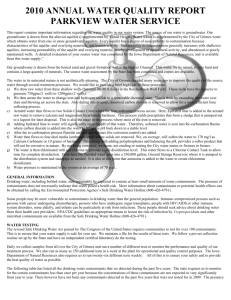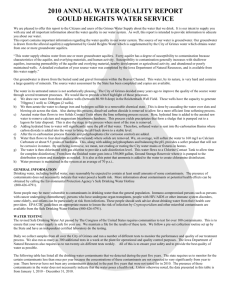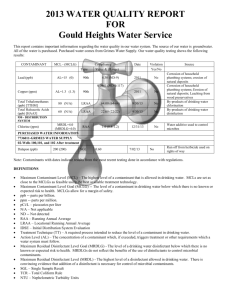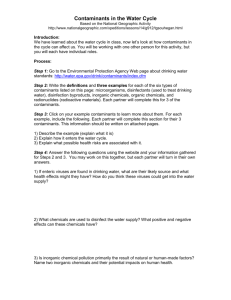2016 Annual Drinking Water Quality Report Western Carolina University
advertisement
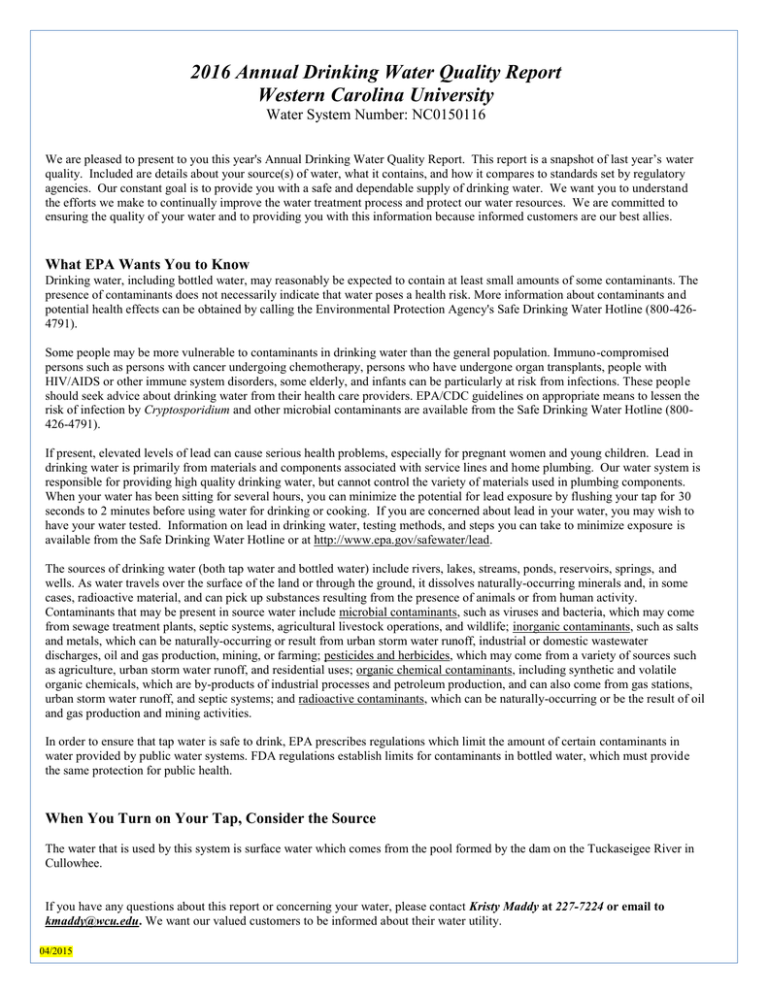
2016 Annual Drinking Water Quality Report Western Carolina University Water System Number: NC0150116 We are pleased to present to you this year's Annual Drinking Water Quality Report. This report is a snapshot of last year’s water quality. Included are details about your source(s) of water, what it contains, and how it compares to standards set by regulatory agencies. Our constant goal is to provide you with a safe and dependable supply of drinking water. We want you to understand the efforts we make to continually improve the water treatment process and protect our water resources. We are committed to ensuring the quality of your water and to providing you with this information because informed customers are our best allies. What EPA Wants You to Know Drinking water, including bottled water, may reasonably be expected to contain at least small amounts of some contaminants. The presence of contaminants does not necessarily indicate that water poses a health risk. More information about contaminants and potential health effects can be obtained by calling the Environmental Protection Agency's Safe Drinking Water Hotline (800-4264791). Some people may be more vulnerable to contaminants in drinking water than the general population. Immuno-compromised persons such as persons with cancer undergoing chemotherapy, persons who have undergone organ transplants, people with HIV/AIDS or other immune system disorders, some elderly, and infants can be particularly at risk from infections. These people should seek advice about drinking water from their health care providers. EPA/CDC guidelines on appropriate means to lessen the risk of infection by Cryptosporidium and other microbial contaminants are available from the Safe Drinking Water Hotline (800426-4791). If present, elevated levels of lead can cause serious health problems, especially for pregnant women and young children. Lead in drinking water is primarily from materials and components associated with service lines and home plumbing. Our water system is responsible for providing high quality drinking water, but cannot control the variety of materials used in plumbing components. When your water has been sitting for several hours, you can minimize the potential for lead exposure by flushing your tap for 30 seconds to 2 minutes before using water for drinking or cooking. If you are concerned about lead in your water, you may wish to have your water tested. Information on lead in drinking water, testing methods, and steps you can take to minimize exposure is available from the Safe Drinking Water Hotline or at http://www.epa.gov/safewater/lead. The sources of drinking water (both tap water and bottled water) include rivers, lakes, streams, ponds, reservoirs, springs, and wells. As water travels over the surface of the land or through the ground, it dissolves naturally-occurring minerals and, in some cases, radioactive material, and can pick up substances resulting from the presence of animals or from human activity. Contaminants that may be present in source water include microbial contaminants, such as viruses and bacteria, which may come from sewage treatment plants, septic systems, agricultural livestock operations, and wildlife; inorganic contaminants, such as salts and metals, which can be naturally-occurring or result from urban storm water runoff, industrial or domestic wastewater discharges, oil and gas production, mining, or farming; pesticides and herbicides, which may come from a variety of sources such as agriculture, urban storm water runoff, and residential uses; organic chemical contaminants, including synthetic and volatile organic chemicals, which are by-products of industrial processes and petroleum production, and can also come from gas stations, urban storm water runoff, and septic systems; and radioactive contaminants, which can be naturally-occurring or be the result of oil and gas production and mining activities. In order to ensure that tap water is safe to drink, EPA prescribes regulations which limit the amount of certain contaminants in water provided by public water systems. FDA regulations establish limits for contaminants in bottled water, which must provide the same protection for public health. When You Turn on Your Tap, Consider the Source The water that is used by this system is surface water which comes from the pool formed by the dam on the Tuckaseigee River in Cullowhee. If you have any questions about this report or concerning your water, please contact Kristy Maddy at 227-7224 or email to kmaddy@wcu.edu. We want our valued customers to be informed about their water utility. 04/2015 Source Water Assessment Program (SWAP) Results The North Carolina Department of Environment and Natural Resources (DENR), Public Water Supply (PWS) Section, Source Water Assessment Program (SWAP) conducted assessments for all drinking water sources across North Carolina. The purpose of the assessments was to determine the susceptibility of each drinking water source (well or surface water intake) to Potential Contaminant Sources (PCSs). The results of the assessment are available in SWAP Assessment Reports that include maps, background information and a relative susceptibility rating of Higher, Moderate or Lower. The relative susceptibility rating of each source for our water system was determined by combining the contaminant rating (number and location of PCSs within the assessment area) and the inherent vulnerability rating (i.e., characteristics or existing conditions of the well or watershed and its delineated assessment area). The assessment findings are summarized in the table below: Susceptibility of Sources to Potential Contaminant Sources (PCSs) Source Name Tuckaseigee River Susceptibility Rating Higher SWAP Report Date July 2015 The complete SWAP Assessment report for Western Carolina University may be viewed on the Web at: www.ncwater.org/pws/swap. Note that because SWAP results and reports are periodically updated by the PWS Section, the results available on this web site may differ from the results that were available at the time this CCR was prepared. If you are unable to access your SWAP report on the web, you may mail a written request for a printed copy to: Source Water Assessment Program – Report Request, 1634 Mail Service Center, Raleigh, NC 27699-1634, or email requests to swap@ncdenr.gov. Please indicate your system name, number, and provide your name, mailing address and phone number. If you have any questions about the SWAP report please contact the Source Water Assessment staff by phone at 919-707-9098. It is important to understand that a susceptibility rating of “higher” does not imply poor water quality, only the system’s potential to become contaminated by PCSs in the assessment area. Help Protect Your Source Water Protection of drinking water is everyone’s responsibility. You can help protect your community’s drinking water source in several ways: do not litter, dispose of chemicals properly, take used motor oil to a recycling center, minimize the use of fertilizers and pesticides especially where runoff may occur, never dump anything down storm drains, conserve water, use non-toxic products when possible, volunteer in your community to participate in group efforts such as the Tuckasegee River Cleanup, etc.). We are required to monitor your drinking water for specific contaminants on a regular basis. Results of regular monitoring are an indicator of whether or not our drinking water meets health standards. We routinely monitor the drinking water for contaminants such as those listed below: (AS) Asbestos - includes testing for Chrysotile, Amphibole and Total Asbestos. (BA) Total Coliform Bacteria – includes testing for Total Coliform bacteria and Fecal/E.coli bacteria. Testing for Fecal/E.coli bacteria is required if total coliform is present in the sample. (DI) Disinfectant Residual must be tested with the collection of each compliance bacteriological sample, at the same time and site. Fecal Indicators – includes E.coli, enterococci or coliphage. (HAA5)- Haloacetic Acids - include Monochloroacetic Acid, Dichloroacetic Acid, Trichloroacetic Acid, Monobromoacetic Acid, Dibromoacetic Acid. (IOC) Inorganic chemicals - include Antimony, Arsenic, Barium, Beryllium, Cadmium, Chromium, Cyanide, Fluoride, Iron, Manganese, Mercury, Nickel, pH, Selenium, Sodium, Sulfate, and Thallium. (LC) Lead and Copper are tested by collecting the required number of samples and testing each of the samples for both lead and copper. (NT) Nitrate/ (NI) Nitrite – includes testing for nitrate and/or nitrite. (RA) Radionuclides - includes Gross Alpha, Radon, Uranium, Combined Radium, Radium 226, Radium 228, Potassium 40 (Total), Gross Beta, Tritium, Strontium 89, Strontium 90, Iodine 131, and Cesium 134. (SOC) – Synthetic Organic Chemicals/Pesticides – include 2,4-D, 2,4,5-TP (Silvex), Alachlor, Atrazine, Benzo(a)pyrene, Carbofuran, Chlordane, Dalapon, Di(2-ethylhexyl)adipate, Di(2-ethylhexyl)phthalate, Dibromochloropropane (DBCP), Dinoseb, Endrin, Ethylene dibromide (EDB), Heptachlor, Heptachlor Epoxide, Hexachlorobenzene, Hexachlorocyclopentadiene, Lindane, Methoxychlor, Oxamyl(vydate), PCBs, Pentachlorophenol, Picloram, Simazine, Toxaphene. (TOC) - Total Organic Carbon - includes testing for Alkalinity, Dissolved Organic Carbon (DOC), Total Organic Carbon (TOC) and Ultraviolet Absorption 254 (UV254). Source water samples must be tested for both TOC and Alkalinity. Treated water samples must be tested for TOC. Source water samples and treated water samples must be collected on the same day. 04/2015 (TTHM) - Total Trihalomethanes - include Chloroform, Bromoform, Bromodichloromethane, and Dibromochloromethane. (VOC) - Volatile Organic Chemicals - include 1,2,4-Trichlorobenzene, Cis-1,2-Dichloroethylene, Xylenes (Total), Dichloromethane, oDichlorobenzene, p-Dichlorobenzene, Vinyl Chloride, 1,1,-Dichloroethylene, Trans-1,2,-Dichloroethylene, 1,2-Dichloroethane, 1,1,1-Trichloroethane, Carbon Tetrachloride, 1,2-Dichloropropane, Trichloroethylene, 1,1,2-Trichloroethane, Tetrachloroethylene, Chlorobenzene, Benzene, Toluene, Ethylbenzene, and Styrene. (WQP) Water Quality Parameters (for Lead and Copper Rule) - includes Orthophosphate (as PO4), pH, Alkalinity and Water Temperature *The results of the contaminants that are listed in this report are only the ones that were detected. All others were not detected in your drinking water for the year of 2015. All that were detected were below the allowable level. Water Quality Data Tables of Detected Contaminants We routinely monitor for over 150 contaminants in your drinking water according to Federal and State laws. The tables below list all the drinking water contaminants that we detected in the last round of sampling for each particular contaminant group. The presence of contaminants does not necessarily indicate that water poses a health risk. Unless otherwise noted, the data presented in this table is from testing done January 1 through December 31, 2015. The EPA and the State allow us to monitor for certain contaminants less than once per year because the concentrations of these contaminants are not expected to vary significantly from year to year. Some of the data, though representative of the water quality, is more than one year old. Important Drinking Water Definitions: Not-Applicable (N/A) – Information not applicable/not required for that particular water system or for that particular rule. Non-Detects (ND) - Laboratory analysis indicates that the contaminant is not present at the level of detection set for the particular methodology used. Parts per million (ppm) or Milligrams per liter (mg/L) - One part per million corresponds to one minute in two years or a single penny in $10,000. Parts per billion (ppb) or Micrograms per liter (ug/L) - One part per billion corresponds to one minute in 2,000 years, or a single penny in $10,000,000. Nephelometric Turbidity Unit (NTU) - Nephelometric turbidity unit is a measure of the clarity of water. Turbidity in excess of 5 NTU is just noticeable to the average person. Action Level (AL) - The concentration of a contaminant which, if exceeded, triggers treatment or other requirements which a water system must follow. Treatment Technique (TT) - A required process intended to reduce the level of a contaminant in drinking water. Maximum Residual Disinfection Level (MRDL) – The highest level of a disinfectant allowed in drinking water. There is convincing evidence that addition of a disinfectant is necessary for control of microbial contaminants. Maximum Residual Disinfection Level Goal (MRDLG) – The level of a drinking water disinfectant below which there is no known or expected risk to health. MRDLGs do not reflect the benefits of the use of disinfectants to control microbial contaminants. Locational Running Annual Average (LRAA) – The average of sample analytical results for samples taken at a particular monitoring location during the previous four calendar quarters under the Stage 2 Disinfectants and Disinfection Byproducts Rule. Maximum Contaminant Level (MCL) - The highest level of a contaminant that is allowed in drinking water. MCLs are set as close to the MCLGs as feasible using the best available treatment technology. Maximum Contaminant Level Goal (MCLG) - The level of a contaminant in drinking water below which there is no known or expected risk to health. MCLGs allow for a margin of safety. 04/2015 Tables of Detected Contaminants Turbidity* Treatment Technique (TT) Violation Y/N Contaminant (units) Turbidity (NTU) - Highest single turbidity measurement N Turbidity (NTU) - Lowest monthly percentage (%) of samples meeting turbidity limits N Your Water 0.329 NTU Likely Source of Contamination MCLG Treatment Technique (TT) Violation if: N/A Turbidity > 1 NTU N/A Less than 95% of monthly turbidity measurements are < 0.3 NTU Soil runoff 99.9 % * Turbidity is a measure of the cloudiness of the water. We monitor it because it is a good indicator of the effectiveness of our filtration system. The turbidity rule requires that 95% or more of the monthly samples must be less than or equal to 0.3 NTU. During the year of 2015, 1 sample out of 976 samples was over 0.3 NTU. The average turbidity of the 976 samples was 0.029 NTU. Lead and Copper Contaminants *TEST REQUIRED EVERY 3 YEARS Sample Date Your Water Number of sites found above the AL Copper (ppm) (90th percentile) 7-11-13 0.35 0 1.3 AL=1.3 Corrosion of household plumbing systems; erosion of natural deposits Lead (ppb) (90th percentile) 7-11-13 <0.003 ND 0 0 AL=15 Corrosion of household plumbing systems; erosion of natural deposits Contaminant (units) Total Organic Carbon (TOC) Contaminant (units) Total Organic Carbon (removal ratio) (TOC)-TREATED MCLG AL Likely Source of Contamination *TESTS DONE QUARTERLY IN 2015 TT Violation Y/N Your Water (RAA Removal Ratio) N 88% Range Monthly Removal Ratio Low - High 56 to 100% 0.8 mg/l to 1.0mg/l MCLG TT Likely Source of Contamination N/A TT Naturally present in the environment Compliance Method (Step 1 or ACC#__) ACC2 Alt. 2 =Treated Water TOC <2.0 mg/l Disinfectant Residuals Summary Year Sampled Chlorine (ppm) 04/2015 2015 MRDL Violation Y/N N Your Water (highest RAA) 0.90 mg/l Range Low 0.79 mg/l MRDLG MRDL 4 4.0 Likely Source of Contamination High 0.93 mg/l Water additive used to control microbes Stage 2 Disinfection Byproduct Compliance - Based upon Locational Running Annual Average (LRAA) Disinfection Byproduct Year Sampled Your MCL Water Violation (highest LRAA) Y/N Range MCLG Low MCL High Byproduct of drinking water disinfection TTHM (ppb) B01 NCCAT B02 Killian Bldg. Likely Source of Contamination 2015 N 37 ppb 28 ppb 48 ppb N/A 80 2015 N 28 ppb 24 ppb 34 ppb N/A 80 Byproduct of drinking water disinfection HAA5 (ppb) B01 NCCAT 2015 N B02 Killian Bldg. 2015 N 35 ppb 29 ppb 44 ppb N/A 60 35 ppb 25 ppb 43 ppb N/A 60 The PWS Section requires monitoring for other misc. contaminants, some for which the EPA has set national secondary drinking water standards (SMCLs) because they may cause cosmetic effects or aesthetic effects (such as taste, odor, and/or color) in drinking water. The contaminants with SMCLs normally do not have any health effects and normally do not affect the safety of your water. Other Miscellaneous Water Characteristics Contaminants Sample Date Your Water 2-4-15 ND 0.3 mg/L Manganese (ppm) 2-4-15 ND 0.05 mg/L Nickel (ppm) 2-4-15 ND N/A Sodium (ppm) 2-4-15 18 mg/l N/A Sulfate (ppm) 2-4-15 17.3 mg/l 250 mg/L pH 2-4-15 7.2 Contaminant (units) Iron (ppm) 04/2015 Range Low 6.9 High 7.5 SMCL 6.5 to 8.5

